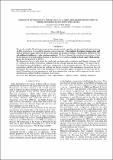Quiescent prominences in the era of ALMA : simulated observations using 3D whole-prominence fine structure model
Abstract
We use the detailed 3D whole-prominence fine structure model to produce the first simulated high-resolution ALMA observations of a modeled quiescent solar prominence. The synthetic brightness temperature and optical thickness maps shown in the present paper are produced using a visualization method for the sub-millimeter/millimeter radio continua synthesis. We have obtained the simulated observations of both the prominence at the limb and the filament on the disk at wavelengths covering a broad range which encompasses the full potential of ALMA.We demonstrate here to what extent the small-scale and large-scale prominence and filament structures will be visible in the ALMA observations spanning both the optically thin and thick regimes. We analyze the relationship between the brightness and kinetic temperature of the prominence plasma. We also illustrate the opportunities ALMA will provide for studying the thermal structure of the prominence plasma from the cool prominence fine structure cores to the prominence-corona transition region. In addition, we show that the detailed 3D modeling of entire prominences with their numerous fine structures will be important for the correct interpretation of future ALMA prominence observations.
Citation
Gunar , S , Heinzel , P , Mackay , D H & Anzer , U 2016 , ' Quiescent prominences in the era of ALMA : simulated observations using 3D whole-prominence fine structure model ' , Astrophysical Journal , vol. 833 , no. 2 , 141 . https://doi.org/10.3847/1538-4357/833/2/141
Publication
Astrophysical Journal
Status
Peer reviewed
ISSN
0004-637XType
Journal article
Collections
Items in the St Andrews Research Repository are protected by copyright, with all rights reserved, unless otherwise indicated.

